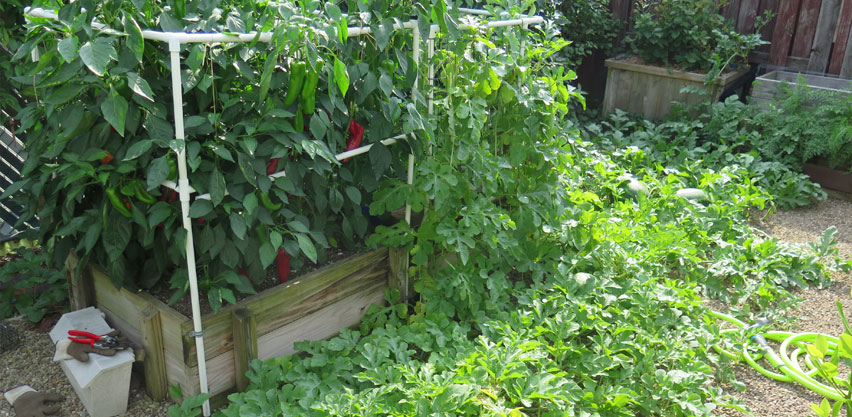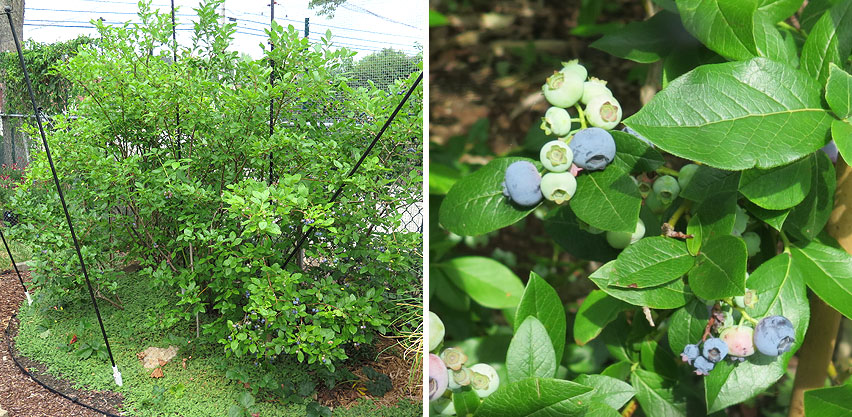Watering Garden Plants with Tap Water
Irrigating with tap water from a garden hose is a simple, easy solution. But there are certain concerns that may impact your plants' performance. Do you need to worry about water temperature when watering your plants? What about chlorinated municipal water? Will it damage your plants or the microorganisms in the soil? What impact does water hardness have on soil salinity?
- How to Protect Plants From Tap Water:
- Is Watering Plants with Cold Water Bad?
- Removing Chlorine From Tap Water to Protect Plants
- Is Chlorinated Tap Water Bad for Plants?
- Why Does Salt Build Up in Soil?
- Watering Plants with Purified Water
Is Watering Plants with Cold Water Bad?
IS TEMPERATURE A CONCERN? Yes! Water temperature can be a real problem for your outdoor plants. But not for the reason you might think. Gardeners are warned to avoid watering plants with ice cold water. Supposedly, this could lead to root shock and may even damage plant roots permanently. Some bloggers claim that watering with cold water can cause plants to go dormant. 🤔 There's no evidence of that. Regardless, such warnings are intended for indoor houseplants. This has nothing to do with watering the garden outdoors. Keep in mind that natural rainfall can get as cold as 32°F. The cold water in your tap won't be that cold during the growing season. If you're wondering: "What temperature is too cold to water plants?" then you need to rephrase that question. It's HOT water that you need to worry about!
HOW HOT CAN HOSE WATER GET??? If your garden hose has been sitting out in the sun it can get very hot. Depending on the ambient temperature, the hose color and its material, the water inside can get hot enough to cause second-degree burns! In places like Arizona or Nevada, "water sitting in a garden hose that's exposed to summer sun can reach up to 190 degrees." Clearly this would be very damaging to your plants and is much more concerning than 40 or 50 degree water.
When you first turn on your hose you may need to cautiously check it. Let it run and cool down before watering your precious veggies. Sure, you could try filling a watering canister the day before (so the water reaches ambient temperature) but that's a small scale solution. Instead, try turning off your garden hose when you're done watering. Drain out any remaining water. And store the hose in the shade away from direct sunlight. This has the added advantage of prolonging hose life by reducing UV light exposure and high heat conditions which my lead to a bursting hose.
High capacity sub-irrigated planters are useful in this regard. My watering hack is to pump the initial burst of heated hose water into the SIP reservoir. The fill tube bypasses plant roots and the hot water quickly dilutes allowing temperatures to normalize. Most of my light colored hose sits in the shade so this little water conservation tricks works in my area. Obviously, I don't advise this in 110°F weather with a filled, 200 foot, black garden hose sitting out in the sun!
Video: Self-Watering Garden Bed:
How the watering system works
The water reservoir in this SIP planter conserves water & boosts plant growth!
Removing Chlorine From Tap Water to Protect Plants
CHLORINATION: Is chlorine bad for your garden? If your water originates from a public sanitation system, it likely has chlorine in it. Chlorine is very effective at eliminating harmful pathogens. But there's concern among gardeners that it could impair plants or at least the beneficial microbes that live in our soils. As a result many people wonder how to get chlorine out of water for plants.
CHLORINE REMOVAL: Gardeners might try leaving water out overnight for plants. Why? Letting water sit for a day or two in an open container will allow chlorine to vent as a gas. How long to let tap water sit before watering plants isn't the real issue. The problem is this passive method doesn't work well for water containing chloramines (chlorine/ammonia compounds). These are more persistent and will remain in the water much longer. Chloramines are present in approximately one-third of all municipal water systems in the US. They are so resistant to off-gassing that even after 5 minutes of boiling, researchers found that 50% of the chloramine remained in water. Interestingly, the chlorine removal process works better when chlorinated water is exposed to sunlight. UV light has been shown to be very effective reducing chlorine levels through the process of photodegradation.
If you have a few house plants to water, this might be a practical thing to try. But on a larger, outdoor garden scale, you would need an active removal system. And those cost money. Of course, capturing rain water (in rain barrels) is an excellent way to bypass this concern. But how concerning should this issue really be?

If you're worried about chlorine, you could allow water containers to sit out. But it's so much easier to just capture rain water!
Is Chlorinated Tap Water Bad for Plants?
SAFE FOR PLANTS? On one hand, chlorine ions are known to have toxic effects on plants, especially when grown hydroponically. However, one study tested various perennial plant species to see how they would respond to varying concentrations of disinfectants. When chlorine concentrations were low (2, 5 or 20 ppm) all plants responded well with less than 4% of any signs of damage. As a reference, EPA safety regulations limit chlorine levels at 4 ppm. Other researchers wanted to test chlorine concentrations similar to tap water. So they selected two chlorine sensitive plants (lettuce and radishes) grown in soil and applied chlorinated solutions. As expected, the plants were damaged by high chlorine concentrations. But the plants were tolerant of low chlorine levels matching standard drinking water rates. They determined chlorinated tap water to be considered safe for growing plants.
SAFE FOR SOIL ORGANISMS? Perhaps plants might be safe, but what about beneficial microorganisms in the soil? According to an article published by the Colorado State University Extension, "Under normal conditions, chlorinated water will not threaten microorganism populations." The explanation revolves around 2 key factors. First, the microorganisms reproduce so quickly that their populations rebound in a very short amount of time. Secondly, the soil particles bind to the Chlorine, trapping it in the upper surface. Thus the beneficial organisms living in the lower soil layers are safeguarded.
So, although rain water may be preferred, watering your garden with chlorinated city water won't cause your plants to fail. You don't need to worry about how to make tap water safe for plants. It's already safe enough. Your organic fertilizers won't come to a screeching halt. Just do the best you can!

These huge pepper & watermelon plants grew perfectly well even though they were irrigated with chlorinated tap water.
Why Does Salt Build Up in Soil?
GOOD SALTS / BAD SALTS? When addressing salts in water or soils, the first thing to recognize is that "salt" is a fairly broad term. A salt is simply an ionic compound formed after a base has reacted with and neutralized an acid. We might instinctively associate salt with sodium chloride (NaCl). But there are all sorts of fertilizer salts which are essential for plant health. Phosphorus and ammonium salts promote plant growth. Fertilizer salts won't kill your plants if they exist in healthy concentrations.
WHY SALTS ARE BAD FOR PLANTS: Many salts are actually good. But if one macronutrient becomes too prevalent, it could lock out other vital nutrients preventing plants from absorbing what they need. In general, if salts accumulate and the concentrations increase, a plant's roots will have difficulty absorbing water due to osmotic pressure. This results in stunted plants which may greatly reduce yields. Sodium in particular can create problems. Plants absorb significant amounts of nitrogen, phosphorus, potassium, calcium, magnesium, sulfur and silicon from soils. That's why these are known as macronutrients. Although sodium is also used by plants, it's a micronutrient that occurs quite sparingly in plant tissues.

Winter salt applications damage plants & can be observed as brown, dried leaf margins.
CAN YOU WATER PLANTS WITH SALT WATER? Yes, you can water plants with salt water (table salt + water) if you want the plants to die. It may seem tongue-in-cheek, but sodium chloride is actually a popular ingredient in DIY homemade weed killers. Along with vinegar, table salt can create such an inhospitable environment that even vigorous weeds can be dried out and killed by it. However, I personally advise against using it. If you apply it in a garden or landscape bed the salt may remain in the soil for quite some time, depending on precipitation rates. Instead of rich fertile soil, you'll be creating a sodic mess that will plague you for a long time. Although Epsom salts (magnesium sulfate) are a less destructive alternative, I prefer to just pull out the stupid weeds.
SOURCES OF SOIL SALTS: Salts can build up in soils from three basic sources. Firstly, salts may be directly applied to an area. In the Winter, salt is often applied to sidewalks and then transferred to the landscape from melt runoff or snow shoveling. Along roadsides, salt trucks may create overspray which seeps into curbside soils. This can be highly destructive to sensitive plants.
Secondly, there are fertilizers which are a source of good salts. These are not a problem as long as application rates are appropriate to your soil and the crops grown. Finally, irrigation water is also a significant salt source, which often includes bad salts. Both well water and municipal tap water may contain several types of salts. City treatment facilities may add sodium fluorosilicate (Na2SiF6) to drinking water through the process of fluoridation. This is not very helpful to plants.
Our tap water often contains calcium or magnesium based salts as well. Plants absorb and used those minerals in larger quantities. Even still, prolonged, repeated irrigations can effect the nutrient content of soil. In particular, an increase in soil calcium levels will likely raise soil pH. This could be an issue with acid loving plants, such as blueberries. Rain water is much better than tap water, in this regard.

Buildup of calcium salts from irrigation water can raise soil pH and damage blueberry plants.
Watering Plants with Purified Water
CAN YOU WATER PLANTS WITH SOFT WATER? Absolutely! Soft water can be a great watering source for plants. But it depends on what you mean by "soft" water. Naturally occurring soft water is simply water that has low levels of dissolved salts like calcium, magnesium or iron ions. Many residents in New York get their water from the Catskill / Delaware watershed. This soft water source has fairly low levels of calcium carbonate. As a result, this tap water is great for irrigation because it doesn't lead to rapid salt accumulation in soils.
Be aware though that this is different from water that was artificially softened by ionic exchange. Those types of water softeners, swap out calcium ions with sodium ions. This increases sodium levels in the tap water. This type of water might be considered "soft" but the higher sodium levels are not beneficial to plants and could accumulate over time. Rather than ionic exchange water softeners, opt for reverse osmosis filters as a way to reduce salt levels in irrigation water.
CAN YOU WATER PLANTS WITH DISTILLED WATER? If ionic exchange water softeners actually make sodium levels worse, is it best to just use distilled water for irrigation? Watering with distilled water is a perfect way to ensure that ZERO salts build up in the soil over time. On a large scale, in an outdoor garden it's completely impractical. The expense would be outrageous and the wasted energy would never justify it. Normal plants don't need such an extreme measure. There are exceptions however. Some plants like orchids, sundews and Venus flytraps have a very poor tolerance for salt buildup. Watering them with distilled water is often recommended. Of course, a free alternative is to simply capture rain water. A single rain event could supply all that you need for an entire growing season!

Due to poor salt tolerance, orchids, sundews & Venus flytraps prefer distilled or rain water.
- To keep salts in check, consider these factors:
- What is in your water? Is it hard water? Is it high in salts?
- How much fertilizers do you use? Overuse of fertilizer contributes to salt build up.
- What type of potting mix do you use? Coir based mixes may have higher salt levels.
- What are your plants' water needs? The more they consume, the more solids left behind.
- What's your container capacity? Less volume means higher concentrations of salts.
← Gravity vs Capillary Watering
Climate Change & Water Conservation →


![Just Add Water [Gardening T-Shirt Design]](images/Just-Add-Water_Gardening-Tshirt-th.jpg)
